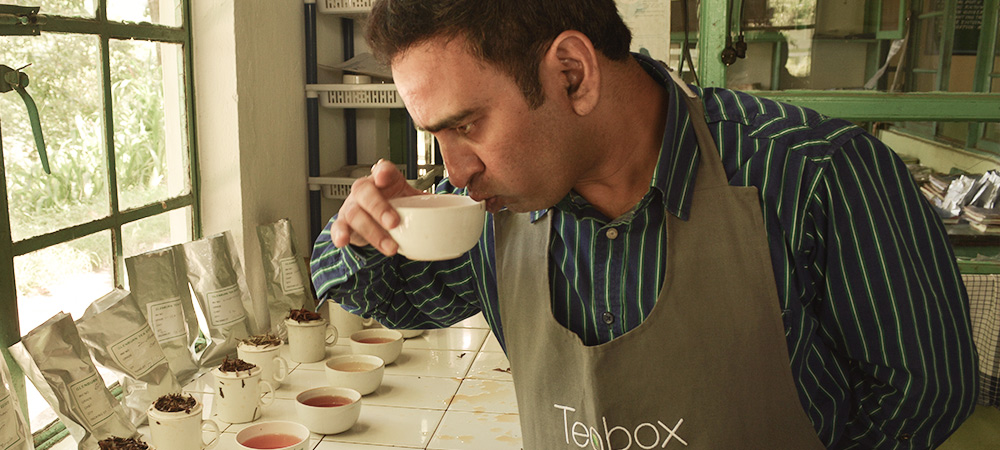Sipping an excellent Formosa oolong from Vietnam’s central highlands, an anomaly in its own right, I ponder the meaning of “tea quality.” I’ve enjoyed so many nice teas, this should be a piece of cake, but I’ve already missed a deadline puzzling over it. Perhaps the problem lies in the nature of the term. It’s cloaked in ambiguity, surrounded by subjectivity, open to fuzzy interpretation.
So, I’ve decided to start at the source of tea quality. Research has shown that “tea quality” originates with raw materials, the tea polyphenols, stored in the tea leaf. These organic compounds, the catechins, theaflavins, tannins, and flavonoids, make up about 25% of leaf volume; the rest is mostly water and cellulose. Polyphenols have been in the news recently because research has shown they promote human health, as well as quality in tea!
Tender, young tea leaf shoots, the so-called “two leaves and a bud, contain more polyphenols than lower leaves; when processed, they yield unusually high-quality tea, compared to stuff made from mature leaf.
[bctt tweet=”To judge tea quality one must taste it.”]
These chemical are not quality, itself; they are the building blocks of quality. The process which brings the quality out takes place in the factory where tea leaf is fed into a roller, which crushes and macerates it. Rolling extracts polyphenols and enzymes from leaf cells and this sap oxides. Oxidized tea polyphenols create the color and clarity, briskness, taste and aroma of brewed tea, the characteristics of good quality tea.
To judge tea quality one must taste it; if you don’t have the opportunity or time to do that, take the word of another whose taste you trust, starting with the tea merchant.
Many online tea retailers upload informative tea-tasting commentary and high-resolution images of tea leaves. This is where you will get your first impressions, but don’t stop there. There are disinterested, non-commercial sites. Even if the tea one’s interested in is not specifically mentioned, there is likely to be data on the relevant tea garden and growing region.
Blogs and group-sourcing sites can be informative, but on-line tea-tasters can be inexperienced or unqualified. I’m sadly reminded of the movies I’ve wasted money on, due to my falling for amateur on-line film reviews. Stick with professional tea-tasters if you can.
By and large, experienced tea-tasters are the best source of information about a tea. They know how to isolate, identify and describe characteristics of quality found in all types of tea: black, oolong and green teas.
[bctt tweet=”By and large, experienced tea-tasters are the best source of information about a tea.”]
First, the taster will describe the dry leaf. It may be whole-leaf or broken leaf, but it will have a characteristic style and shape, a certain look, if you will. Is it attractive or plain, symmetrical or rangy? Is it carefully sorted for size and winnowed of extraneous materials, such as stem and dust? Does it boast a smattering of gold or silver tips?
The taster will then move on to the liquor. Does it have clarity, reflectiveness and a distinct hue; a pleasing (but not jarring) aroma, redolent of flowers, fruit, vegetable matter, wood smoke or some other desirable substance? The taste should be complex and neither overpowering nor weak. A high-quality tea is noteworthy and memorable and will elicit specific positive comments.
Beware of a tea described as mild, smooth or light. These are not words of quality. One wishes for a stimulating cup, not the blandness of Chinese restaurant tea. Be sure to note comments about bitterness and astringency, two distinct and unrelated qualities. Good mouth feel (astringency) is desirable. Bitterness can be interesting, if subtle, but you don’t want to experience extremes in either case.
When buying black tea one often encounters an array of letters attached thereto, such as FOP, TGFOP, BOP, BOPF, etc. These are about the size and cut of the leaf, rather than quality. It’s true: “T” stands for “tippy” and “F” for “flowery,” but don’t let these symbols prejudice your palate.
Finally, listen to feedback from the marketplace. Tea-tasters are the first to weigh in. They pick the initial winners and losers in the tea quality game. Tea wholesalers and retailers, with their value-for-money orientation, follow the tea-taster’s guidelines closely. That is why we can say price is linked to quality. If the tea leaf is the harbinger of tea quality, the tea-taster is the arbiter. In the end, you usually get what you pay for.
Image: A tea tasting session at the Glenburn Tea Estate, Darjeeling

